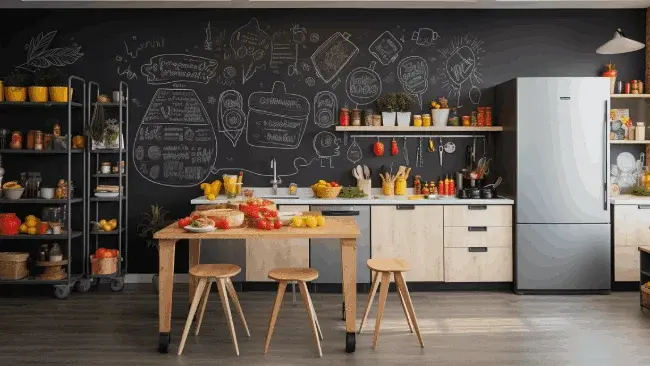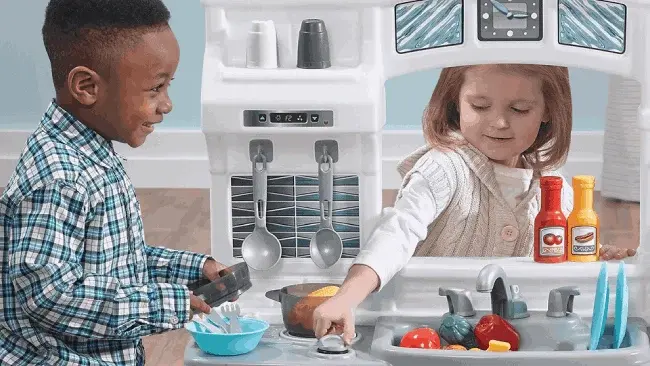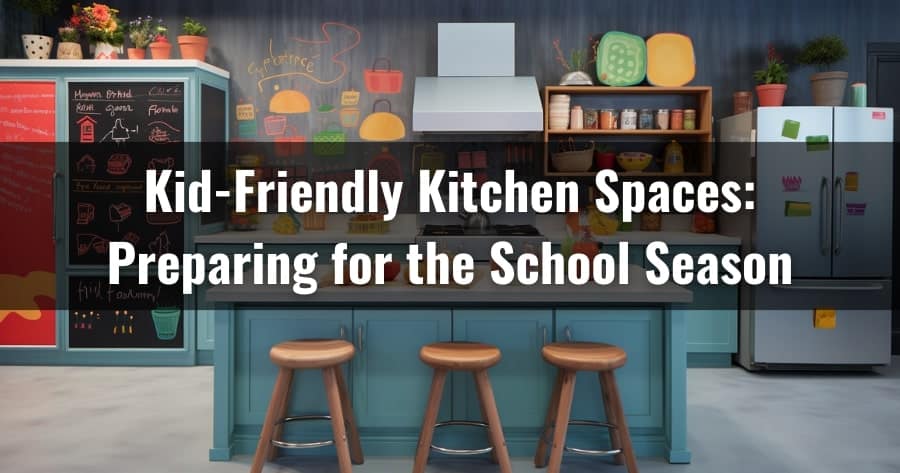Kitchens need to be kid-friendly and organized as the school season approaches, catering to the demands of hectic schedules. It takes thoughtful design and practical considerations to integrate children seamlessly into the culinary landscape.
Set up an organized lunch station so that you can pack nutritious meals for your children without stress in the morning. Arrange snack areas and after-school preparation zones, making it easy for your kids to grab a quick bite or prepare their snacks.
Don’t forget to organize your pantry and refrigerator efficiently, ensuring everything is easily accessible for you and your children.
Here, we’ll demonstrate how to arrange your kitchen spaces to make the space kid-friendly, especially during school season. Also, you will discover if your children can assist you in the kitchen after school.
Jump to Section
Kid-Friendly Kitchen Spaces: Eight Considerations for School Season
Get ready to dive into the world of kid-friendly kitchen spaces that will make meal prep and after-school snacks a breeze.

With our time-saving meal prep strategies, you’ll have more time to spend with your family and less time in the kitchen. Here we go:
No 01: Set up an Organized Lunch Station
Designate a specific area in your cupboard for lunch box items, making it easy for your children to access everything they need. Use labeled bins to separate sandwiches, fruit, and snacks, ensuring everything is properly placed.
Doing this will streamline your morning routine and allow your kids to make lunches without causing chaos in the kitchen. This will save you time and energy and foster independence and responsibility in your children as they take charge of their meal preparations during their school season.
No 02: Arrange Snack Areas and After-School Preparation
To further enhance your kid-friendly kitchen space, organize designated snack areas and encourage after-school preparation with your children.
Create shelves or drawers specifically for grab-and-go snacks like cheese strings and yogurts. This way, your kids can easily access these healthy options without disrupting dinner preparation.
By involving them in after-school snack preparation, you teach them essential cooking techniques and promote a sense of accomplishment as they contribute to their well-being.
Encourage them to choose their snacks and help them assemble simple recipes like fruit skewers or veggie wraps. This practice ensures your children have a satisfying snack and fosters independence and responsibility.
No 03: Efficient Pantry and Refrigerator Organization
Designate specific areas in the refrigerator for snacks and lunch items. Use clear bins to keep everything organized and easily accessible. This way, your kids can quickly grab what they need when packing their lunches or looking for an after-school snack.
In the pantry, opt for glass storage containers for baking supplies. Not only do they look nice, but they also allow you to see exactly what you have without digging through bags and boxes.
Also, take inventory of your condiments and eliminate anything that’s expired or rarely used. This will help declutter your pantry and make meal planning a breeze.
No 04: Establish Homework-Friendly Seating
Create a comfortable and productive homework environment by incorporating designated seating areas in your kitchen.
Having a specific place for your child to sit and focus on their homework while school is in session can help them stay organized and motivated. Consider adding comfortable chairs or bar stools near the kitchen island or countertop, where they can work while you prepare meals.
Dual islands in the kitchen floor plan can provide a practical solution for parents supervising their children’s homework. Ensure that outlets and USB ports are included in these seating areas so your child can easily charge their devices and complete their assignments without interruptions.
No 05: Put Child-Accessible Cooking Tools
Make meal preparation more interactive for your child by ensuring they can access various child-friendly cooking tools. Installing lower cabinets or drawers with safe knives, mixing bowls, and measuring utensils allows kids to actively participate in meal preparation and develop their cooking expertise.

Having designated spaces for these tools promotes a child-friendly kitchen design and encourages hands-on learning beyond school hours. Children who can easily access these cooking tools feel empowered and more motivated to get involved in the kitchen. It helps them develop their confidence and teaches them valuable life lessons.
No 06: Create a Color-Coded Organization
Enhance your child’s kitchen experience by implementing a color-coded organization system to access ingredients and snacks easily. With this simple and effective technique, you can create a visually appealing and organized space to make cooking and snacking a breeze for your little ones.
Use different colored labels or containers to categorize food items based on their types. For example, you can assign blue for fruits, green for vegetables, and red for snacks. A balanced diet and an understanding of different food groups will help your child during the academic year.
No 07: Set up Educational Culinary Activities
Get your child excited about learning in the kitchen with educational culinary activities that will engage their senses and teach them valuable cooking skills.
You can start by introducing your child to simple recipes that involve basic cooking techniques. This will help them develop important skills such as measuring ingredients, following instructions, and understanding cooking times.
The culinary experience can also be connected to educational concepts such as math and science. For example, you can teach your child about fractions by having them measure ingredients or explore the chemical reactions that occur when baking.
No 08: Follow Time-Saving Meal Prep Strategies
To prepare for the school season efficiently, incorporate time-saving meal prep strategies in your kid-friendly kitchen space. Planning and preparing meals in advance can save you time and effort during busy weekdays.
Take advantage of weekends or evenings to cook and store weekly meals. Batch cooking and freezing options are great ways to have ready-made meals that can be quickly reheated. This reduces your stress levels and ensures that your family has access to nutritious and delicious meals.
According to kitchen experts, these time-saving meal prep strategies can help you create an organized and efficient kitchen that eases the transition to school.
FAQ’s: Kid-Friendly Kitchen Spaces
How can children help their parents in the kitchen?
We believe you can involve your children in the kitchen during the school season by assigning them age-appropriate tasks. Younger kids can help with simple tasks like stirring or setting the table. They can also assist with washing fruits and vegetables or measuring ingredients.
Older kids can take on more responsibility, such as cracking eggs or chopping vegetables. For teenagers, you can encourage their participation by allowing them to choose a dish and helping them prepare it. This can be a fun way to bond with your teenager while teaching them important cooking techniques.
How does a play kitchen help a child’s cognitive development?
A play kitchen helps a child’s cognitive development during their school season. Based on an expert chef, children can enhance their problem-solving skills by playing pretend. They learn to think creatively and find solutions to imaginary cooking challenges.

Counting, measuring, and sorting ingredients in a play kitchen also helps children develop mathematical abilities. They can practice basic arithmetic, understand measurements, and grasp the concept of time.
How can I create a kid-friendly kitchen on a budget?
Creating a budget-friendly, kid-friendly kitchen for the school season involves strategic choices. Utilizing affordable organizational products available at budget-friendly retailers and focusing on practical solutions increase functionality without going over budget.
Consider designating specific snack areas, setting up a homework-friendly space with existing furniture, and incorporating color-coded labels for easy organization. Practical adjustments, such as lower drawers for child-accessible tools, empower kids to participate actively in meal preparation.
Conclusion
Creating a kid-friendly kitchen space is essential for a smooth school season. Organizing and decluttering can make cooking and meal prep fun for the whole family. Incorporating colorful and age-appropriate utensils and tools can spark excitement and encourage children to participate in the kitchen.
Through these thoughtful transformations, the kitchen becomes a functional space for meal preparation and a location for shared experiences, learning and cultivating lifelong skills. So get ready to whip up delicious and nutritious meals together, making the school season a breeze and creating lasting memories.





